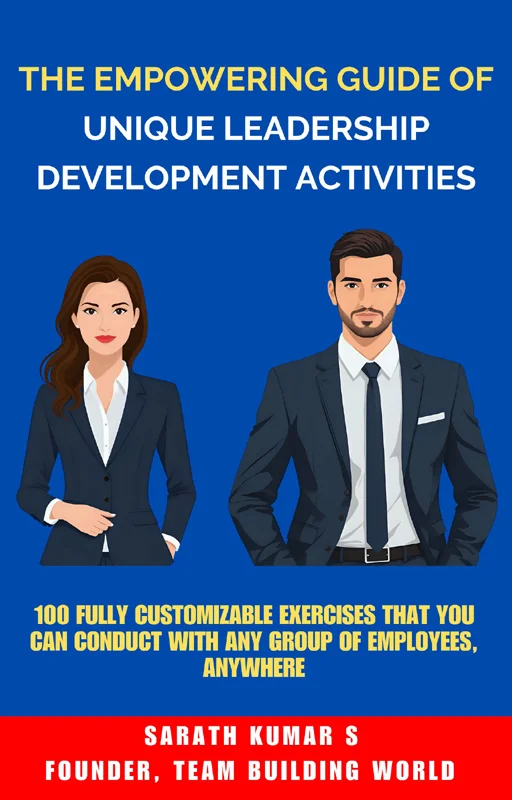10 Employee Relations Activities for Leaders
Are you in search of employee relations activities?
Building strong relationships with employees is key to fostering a positive workplace culture. Strong employee relations boost morale, increase productivity, and reduce turnover.
In this article, let’s see 10 impactful activities that leaders can implement to cultivate meaningful connections with their employees.
What are Employee Relations Activities?
Employee relations activities are initiatives designed to strengthen the bond between leaders and employees. They contribute to creating a supportive and collaborative work environment where everyone feels valued. Some of their benefits are:
Improved Communication
Effective employee relations promote open communication, ensuring that employees feel heard and understood. This leads to better teamwork and faster resolution of workplace challenges.
Higher Employee Engagement
Activities that focus on relationships help employees feel more connected to their work. Engaged employees are more likely to go above and beyond in their roles.
Reduced Workplace Conflict
By fostering stronger relationships, potential misunderstandings and disputes can be minimized. This creates a more harmonious and cooperative workplace atmosphere.
Increased Retention Rates
Positive employee relations encourage loyalty and job satisfaction. Employees are less likely to leave when they feel supported and appreciated.
Boosted Productivity
Employees who feel valued tend to perform better and contribute more effectively. Strong workplace relationships keep teams motivated to achieve common goals.
Enhanced Organizational Culture
Prioritizing employee relations helps build a culture of trust and respect. A healthy culture attracts top talent and promotes long-term success.
10 Employee Relations Activities for Leaders
Here are some ways that leaders can actively foster positive employee relations in the workplace.
#1. Host Regular One-on-One Meetings
Regular one-on-one meetings provide a dedicated space for open communication between leaders and employees. These meetings allow leaders to understand individual challenges, provide guidance, and help employees align their work with organizational goals. To make these sessions effective, consider the following:
- Set a Clear Agenda: Share a structured agenda ahead of time to ensure meaningful discussions.
- Practice Active Listening: Focus on truly hearing employee concerns without interruptions.
- Offer Constructive Feedback: Provide balanced feedback that reinforces strengths while addressing areas for improvement.
- Discuss Career Growth: Use the opportunity to talk about professional development and future aspirations.
- Review Actionable Goals: End the meeting with clear next steps or objectives to keep progress on track.
You can also read: 10 Compensation Management Strategies for Leaders
#2. Celebrate Milestones and Achievements
Recognizing accomplishments boosts morale and reinforces a culture of appreciation within the workplace. This can be achieved through both formal and informal methods of acknowledgment. Here are a few effective strategies:
- Team Announcements: Publicly highlight individual or team achievements during meetings or through company-wide communications.
- Personalized Notes: Send a handwritten or personalized email expressing gratitude for specific contributions.
- Reward Programs: Implement a system where employees can earn rewards such as gift cards or additional time off for exceptional performance.
- Social Media Spotlights: Share employee successes on your company’s social platforms to celebrate them with a wider audience.
- Peer Recognitions: Encourage team members to recognize and celebrate each other’s efforts, fostering mutual appreciation.
#3. Encourage Team Building Activities
Organizing team building activities is a great way to strengthen relationships and improve collaboration within the workplace. These activities should be designed to promote trust, communication, and a sense of camaraderie among employees. Below are some ideas to help foster an engaging and dynamic team environment:
- Interactive Workshops: Host workshops that focus on communication skills, leadership development, or creative problem-solving.
- Volunteer Opportunities: Arrange group volunteering events to give back to the community while building team spirit.
- Outdoor Adventures: Plan activities like hiking, team sports, or ropes courses to encourage teamwork in an exciting setting.
- Game Days: Organize games such as trivia, board games, or friendly competitions to create a fun and relaxed atmosphere.
- Team Challenges: Develop challenges like escape rooms or scavenger hunts to encourage collaboration and strategic thinking.
#4. Organize Feedback Sessions
Feedback sessions are integral for fostering open communication and continuous improvement within a team. They provide a platform to discuss achievements, address concerns, and set future goals collaboratively. To ensure productive and engaging sessions, consider the following tips:
- Set Clear Objectives: Define what the feedback session aims to achieve and share the agenda in advance.
- Encourage Participation: Create a safe space where everyone feels comfortable sharing their thoughts and ideas.
- Focus on Solutions: Highlight actionable steps and constructive feedback instead of dwelling on problems.
- Recognize Achievements: Celebrate team and individual successes to boost morale and motivation.
- Follow Up: After the session, ensure that action points are documented and progress is tracked over time.
#5. Provide Professional Development Opportunities
Investing in professional development is a crucial step toward fostering growth and retaining talent within an organization. Providing opportunities for employees to expand their skillsets can lead to greater job satisfaction and improved performance. Below are some key ways to support professional growth:
- Offer Training Programs: Organize workshops, seminars, or online courses tailored to enhance relevant skills.
- Encourage Mentorship: Pair employees with experienced mentors to guide them in their career paths.
- Support Continuing Education: Provide reimbursement or financial aid for advanced degrees or certification programs.
- Facilitate Networking Events: Create opportunities for employees to connect with industry professionals and peers.
- Promote Leadership Development: Identify high-potential individuals and offer programs to cultivate their leadership abilities.
#6. Foster a Transparent Work Environment
Transparency in the workplace is vital for building trust and ensuring smooth communication across all levels. It encourages employees to share ideas, provide feedback, and address concerns without hesitation, creating a healthier work culture. Here are actionable ways to foster transparency:
- Open Communication Channels: Establish regular meetings and feedback sessions to encourage dialogue and collaboration.
- Share Strategic Goals: Clearly outline the company’s objectives and how everyone’s work contributes to them.
- Provide Access to Information: Ensure employees can easily access relevant data, updates, and decisions affecting their work.
- Encourage Accountability: Clearly define roles and responsibilities so every employee understands their impact.
- Be Honest and Consistent: Leaders should model transparency by openly sharing successes, setbacks, and future plans.
#7. Facilitate Cross-Department Collaboration
Effective cross-department collaboration is critical for achieving shared goals and fostering innovation. It requires clear communication, trust, and efficient workflows to ensure teams can work in harmony. Below are five key strategies to facilitate better collaboration across departments:
- Establish Shared Goals: Define common objectives that align with the organization’s vision to encourage teamwork and synergy.
- Leverage Technology: Use collaboration tools like project management software to streamline communication and task management.
- Promote Regular Meetings: Schedule cross-team check-ins to discuss progress, resolve conflicts, and exchange ideas.
- Foster Mutual Respect: Encourage departments to value each other’s expertise and contributions to avoid silos.
- Provide Leadership Support: Ensure leaders actively champion collaboration efforts and address any roadblocks.
#8. Promote Work-Life Balance
Maintaining work-life balance is essential for both productivity and employee well-being. Organizations should take proactive steps to help their teams achieve this balance, leading to improved satisfaction and performance. Some effective strategies include:
- Flexible Work Arrangements: Offer options like remote work, flexible hours, or hybrid models to accommodate individual needs.
- Encourage Time Off: Actively promote the use of vacation days and discourage overworking to reduce burnout risks.
- Support Mental Health: Provide resources such as counseling services, wellness programs, and mental health days.
- Set Clear Boundaries: Define expectations around work hours and ensure employees are not expected to be “always on.”
- Encourage Regular Breaks: Advise employees to step away from their desks periodically to recharge and refocus.
#9. Be a Role Model for Positive Behavior
Leaders play an essential role in shaping workplace culture and fostering a positive environment. By exemplifying healthy habits and behaviors, they inspire employees to follow suit. Below are five actionable ways leaders can set the tone for positivity and balance:
- Communicate Transparently: Share goals, company updates, and decisions with clarity to build trust.
- Celebrate Successes: Recognize accomplishments frequently, both big and small, to boost morale.
- Practice Active Listening: Show genuine interest in feedback and concerns to create a safe space for dialogue.
- Demonstrate Work-Life Balance: Take breaks, use vacation days, and respect personal time to set a strong example.
- Promote Collaboration: Encourage teamwork and inclusivity to foster stronger connections as well as better outcomes.
#10. Recognize and Support Inclusion
Creating an inclusive environment requires intentional effort and consistent practices. It is important to not only value diversity but also implement strategies that ensure everyone feels welcome and supported. Below are five key ways to recognize and foster inclusion:
- Educate Yourself and Others: Provide training and resources to increase awareness about different cultures, identities, and perspectives.
- Encourage Diverse Voices: Create opportunities for underrepresented individuals to contribute and lead.
- Address Bias: Recognize and actively combat unconscious bias in decision-making as well as interactions.
- Adapt Policies: Regularly update organizational policies to ensure they support equity and inclusion.
- Celebrate Diversity: Acknowledge and celebrate cultural events, milestones, as well as achievements that reflect the diversity of the team.
Want Some Unique Leadership Development Activities?
If you want some unique activities to equip your employees (both in-person and virtual) with leadership skills, qualities, and mindset, you can get my new e-book:
Or Want Some Unique Team Building Activities?
If you want some unique activities for your employees (both in-person and virtual), you can get my new e-book:
Final Words
Building stronger employee relationships doesn’t happen overnight, but these activities are small, actionable steps that can make a significant impact over time. By actively investing in these practices, leaders can create a more engaged, connected, and satisfied workforce. Remember, communication and relationships are the foundation of a successful workplace. So, invest time as well as effort in building strong employee relationships and watch your organization thrive.
FAQ: Employee Relations Activities
You might have these questions in mind.
Why are employee relations activities important?
They are crucial because they build trust and mutual respect within the workplace. Strong employee relationships lead to higher job satisfaction and productivity. Furthermore, they help reduce conflicts and create a positive work environment.
How can leaders implement these activities?
Leaders can start by identifying the specific needs of the team and creating opportunities for collaboration. Scheduling regular one-on-one check-ins and team-building events is a great place to begin. Consistent communication and inclusive policies will further reinforce the effectiveness of these activities.
What role does leadership play in employee relations?
Leadership is crucial in fostering strong employee relations. Leaders set the tone for workplace culture by promoting inclusivity, open communication, and mutual respect. When leaders actively engage with their teams and model positive behaviors, they encourage collaboration as well as trust throughout the organization. They also play a critical role in addressing and resolving conflicts that may arise between employees, ensuring fair treatment for all.
How can technology enhance employee relations?
Technology offers tools that make it easier to connect and engage with employees. Platforms for team collaboration, recognition programs, and feedback systems streamline communication. They also ensure that employees feel heard and valued. Leveraging technology can also help track progress and improve employee satisfaction over time.
What are some common challenges in employee relations?
Common challenges include miscommunication, lack of recognition, and resistance to change. These issues can result in decreased morale and productivity if not addressed proactively. By fostering a transparent as well as supportive environment, organizations can mitigate these challenges and encourage a positive workforce dynamic. Additionally, cultural and generational differences can also create challenges in employee relations.

